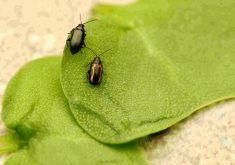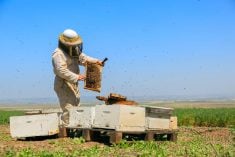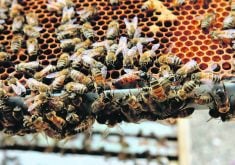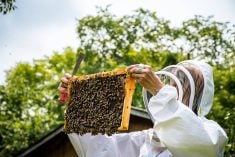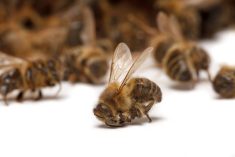Steps taken to protect honeybees from crop protection products appear to be working.
The number of honeybee colonies and their level of production has been rising since 2013, according to testimony to the Senate agriculture committee.
Andrea Johnson, Agriculture and Agri-Food Canada (AAFC) director general of sector development told the committee the most recently available numbers are encouraging.
“Canada’s 8,533 beekeepers produced 95.3 million pounds of honey in 2015, up 11 per cent from 2014,” Johnson said. “This represents a value of over $232 million.”
She added the total economic contribution of honeybee pollination is thought to range from $3.15 billion to $4.39 billion annually.
Read Also

Journal pulls long-cited glyphosate study for ethics violations
The journal Regulatory Toxicology and Pharmacology has retracted a 2000 Monsanto-linked glyphosate review, drawing new scrutiny as Bayer faces mounting legal pressure.
The total number of honeybee colonies in Canada reached 721,000 in 2015, which represents a 3.6 per cent increase over 2014 and is nine per cent higher than the previous five-year average population, she added. There was no information on the state of wild bee species and other pollinators.
Scott Kirby, director of environmental evaluation at Health Canada’s Pest Management Regulatory Agency (PMRA), said mitigation measures implemented in 2014 have been effective in reducing bee mortality.
“The number of incidents reported during the planting periods of 2014 and 2015 decreased by approximately 70 per cent and 80 per cent respectively from the numbers reported in 2013, which is a significant improvement,” he said. “Reports from the 2016 planting season indicate that the positive trend we’ve observed in the past two years has continued.”
As for three neonic insecticides that are usually portrayed as the villains in bee deaths, Kirby said a preliminary assessment for imidacloprid found no significant risks for honeybees were identified.
“Re-evaluation of other health and environment aspects of imidacloprid is ongoing and we expect to publish these findings later this year,” he noted. “Pollinator assessments for clothianidin and thiamethoxam will follow in 2017. These re-evaluations continue to be a priority to the PMRA, and we will continue to consult on decisions with all stakeholders.”
He added that bee health is a complex issue and more work is required to understand all the factors which contribute to periodic increases in mortality. To that end the government is working with national and international organizations “to generate the knowledge we need to protect the long-term health of bee populations in Canada and worldwide.”
Johnson said that a Bee Health Roundtable set up by Agriculture Canada has widespread membership that recognizes “that bee health requires a long-term, multi-faceted commitment of time, co-ordination and resources.”
It has working groups “addressing research, pollinator habitat and surroundings, varroa mite control, reduction of pesticide exposure, honeybee nutrition, best management practices and communications.”
Among the projects it has completed are “national best management practices, integrating regional approaches where appropriate in a format ready for distribution to beekeepers. This will be published and shared with stakeholders in the coming weeks.”
A nutrition working group is engaged with partners in a major U.S. international bee nutrition research effort to ensure that Canadian perspectives and issues are addressed, she added.
Agriculture Canada has beefed up its bee research capacity, noted Stephen Pernal from the Beaverlodge Research Farm. It is working on honeybee issues such as detecting and treating colonies infected with Nosema ceranae, a newly introduced parasite associated with higher rates of colony losses. “In addition, we are developing techniques to disinfect beekeeping equipment exposed to this pest and methods to detect products used for its treatment that may persist in beehives.
“We are also continuing to analyze samples from agriculture pesticide residues in honey, pollen and beeswax throughout Alberta. Moreover, we are examining concentrations of products currently registered for the control of diseases or mites of honeybees that may also accumulate in these matrices.”



